stop start TOYOTA 4RUNNER 2013 N280 / 5.G Quick Reference Guide
[x] Cancel search | Manufacturer: TOYOTA, Model Year: 2013, Model line: 4RUNNER, Model: TOYOTA 4RUNNER 2013 N280 / 5.GPages: 32, PDF Size: 10.16 MB
Page 4 of 32
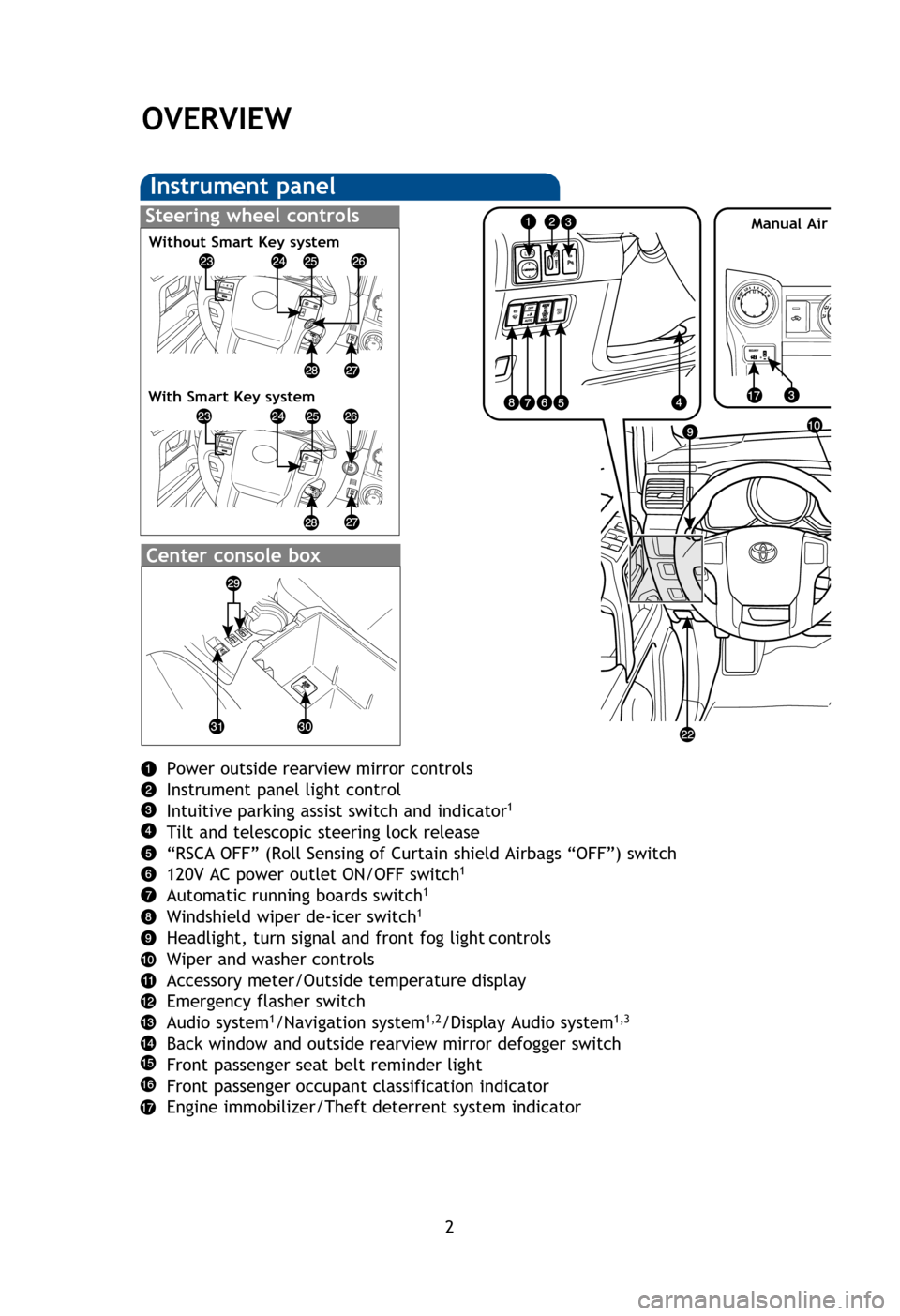
2
Power outside rearview mirror controls
Instrument panel light control
Intuitive parking assist switch and indicator
1
Tilt and telescopic steering lock release
“RSCA OFF” (Roll Sensing of Curtain shield Airbags “OFF”) switch
120V AC power outlet ON/OFF switch
1
Automatic running boards switch1
Windshield wiper de-icer switch1
Headlight, turn signal and front fog light controls
Wiper and washer controls
Accessory meter/Outside temperature display
Emergency flasher switch
Audio system
1/Navigation system1,2/Display Audio system1,3
Back window and outside rearview mirror defogger switch
Front passenger seat belt reminder light
Front passenger occupant classification indicator
Engine immobilizer/Theft deterrent system indicator
OVERVIEW
Instrument panel
Steering wheel controls
Center console box
12V DC power outlet
AUX/USB port1
Front-wheel drive control lever
Four-wheel drive selector1
Hood release
Steering wheel audio controls1,2,3
Voice command button1,2,3
Telephone switches1,2,3
Ignition switch (standard key)1/“ENGINE START STOP” button (Smart Key)1
Party mode switch
Cruise control
Seat heater switch
1
120V AC power outlet1
Power back window switch
1 If equipped2 For details, refer to the “Navigation System Owner’s Manual.”3 For details, refer to the “Display Audio System Owner’s Manual.”
Without Smart Key system
With Smart Key systemManual Air Conditioning
126892_20134Runner.indd 28/6/12 10:40 PM
Page 5 of 32
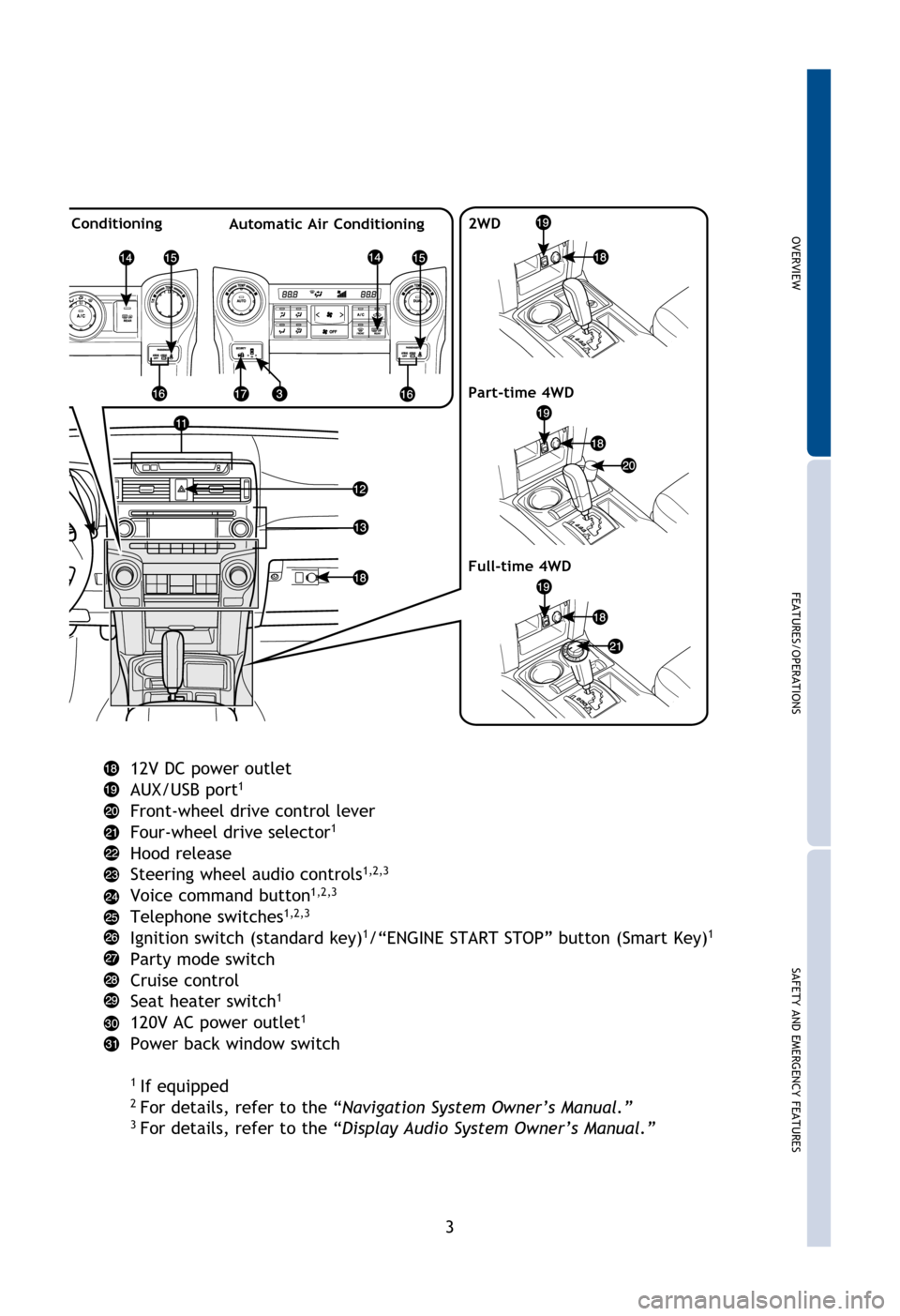
OVERVIEW
FEATURES/OPERATIONS
SAFETY AND EMERGENCY FEATURES
3
Power outside rearview mirror controls
Instrument panel light control
Intuitive parking assist switch and indicator
1
Tilt and telescopic steering lock release
“RSCA OFF” (Roll Sensing of Curtain shield Airbags “OFF”) switch
120V AC power outlet ON/OFF switch
1
Automatic running boards switch1
Windshield wiper de-icer switch1
Headlight, turn signal and front fog light controls
Wiper and washer controls
Accessory meter/Outside temperature display
Emergency flasher switch
Audio system
1/Navigation system1,2/Display Audio system1,3
Back window and outside rearview mirror defogger switch
Front passenger seat belt reminder light
Front passenger occupant classification indicator
Engine immobilizer/Theft deterrent system indicator
OVERVIEW
12V DC power outlet
AUX/USB port1
Front-wheel drive control lever
Four-wheel drive selector1
Hood release
Steering wheel audio controls1,2,3
Voice command button1,2,3
Telephone switches1,2,3
Ignition switch (standard key)1/“ENGINE START STOP” button (Smart Key)1
Party mode switch
Cruise control
Seat heater switch
1
120V AC power outlet1
Power back window switch
1 If equipped2 For details, refer to the “Navigation System Owner’s Manual.”3 For details, refer to the “Display Audio System Owner’s Manual.”
Manual Air ConditioningAutomatic Air Conditioning 2WD
Part-time 4WD
Full-time 4WD
126892_20134Runner.indd 38/6/12 10:40 PM
Page 8 of 32

6
OVERVIEW
Fuel tank door and cap
PullTurn to open
NOTE: Tighten until one click is heard. If the cap is not properly sealed, Check
Engine “
” indicator may illuminate.
Keyless entry
Locking
Unlocking
Panic button
Push and hold
NOTE: If a door is not opened within 60 seconds of unlocking, all doors will relock
for safety.
Push ONCE: Driver door
TWICE: All doors
Push
Without Smart Key systemWith Smart Key system
Without Smart Key systemWith Smart Key system
Smart Key system (if equipped)
Start function
ACCESSORY
ON
OFF
NOTE: Gear shift lever must be in Park and brake pedal depressed.
Without depressing the brake pedal, pressing the “ENGINE START STOP” switch
will change the operation mode in succession from:
NOTE: Doors may also be locked/unlocked using remote.
Power (without starting engine)
Locking
Carry remote to lock/unlock/open
Back door lock/unlock/open
Carry remote to lock
126892_20134Runner.indd 68/6/12 10:40 PM
Page 9 of 32
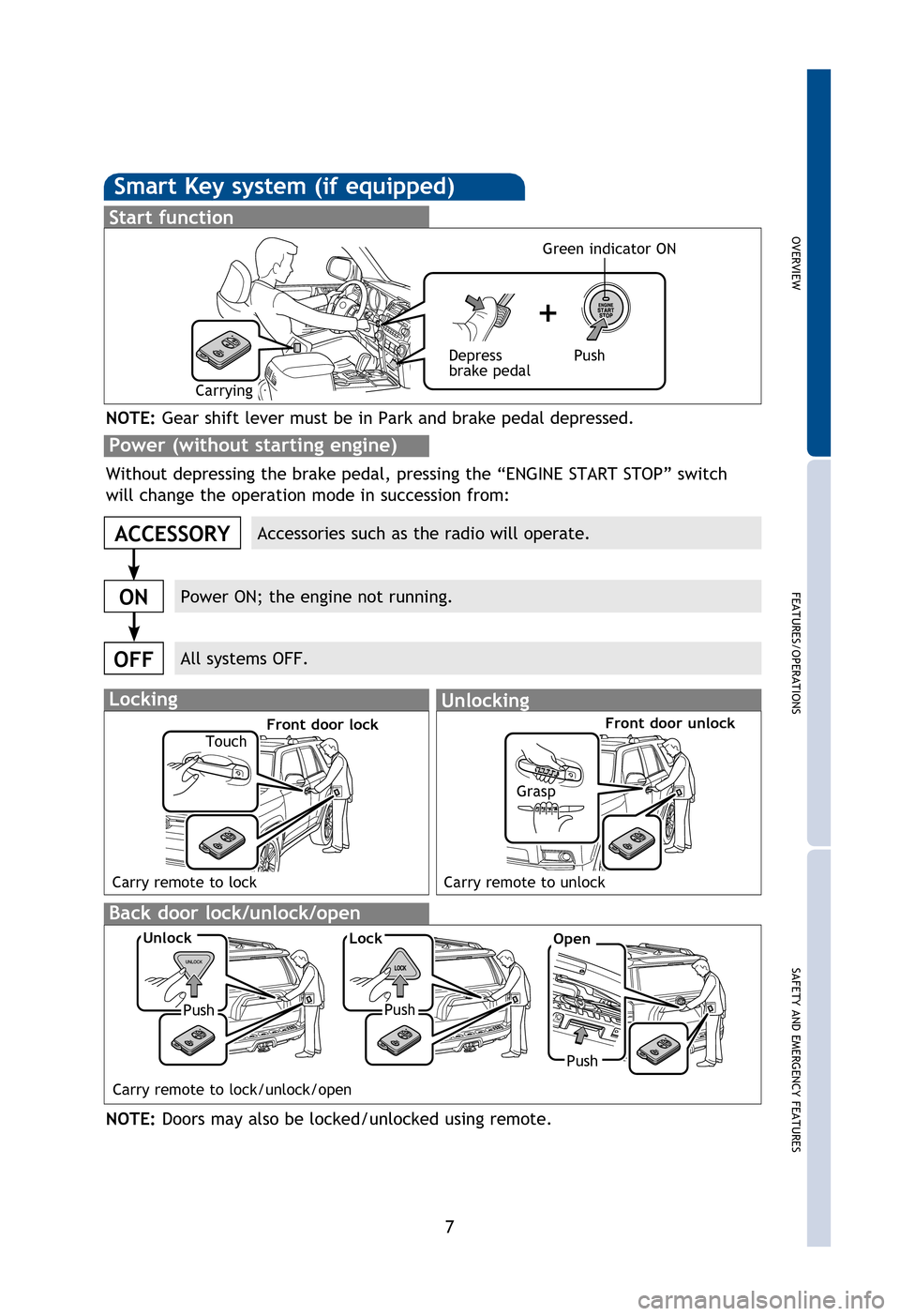
OVERVIEW
FEATURES/OPERATIONS
SAFETY AND EMERGENCY FEATURES
7
NOTE: Tighten until one click is heard. If the cap is not properly sealed, Check
Engine “
” indicator may illuminate.
NOTE: If a door is not opened within 60 seconds of unlocking, all doors will relock
for safety.
Smart Key system (if equipped)
Start function
Accessories such as the radio will operate.
Power ON; the engine not running.
All systems OFF.
ACCESSORY
ON
OFF
NOTE: Gear shift lever must be in Park and brake pedal depressed.
Push
Depress
brake pedal
Carrying
Green indicator ON
Without depressing the brake pedal, pressing the “ENGINE START STOP” switch
will change the operation mode in succession from:
NOTE: Doors may also be locked/unlocked using remote.
Power (without starting engine)
Push
Unlock
Push
Lock
LockingUnlocking
Carry remote to unlock
Front door lockFront door unlock
Grasp
Carry remote to lock/unlock/open
Back door lock/unlock/open
Carry remote to lock
Touch
Open
Push
126892_20134Runner.indd 78/6/12 10:41 PM
Page 10 of 32
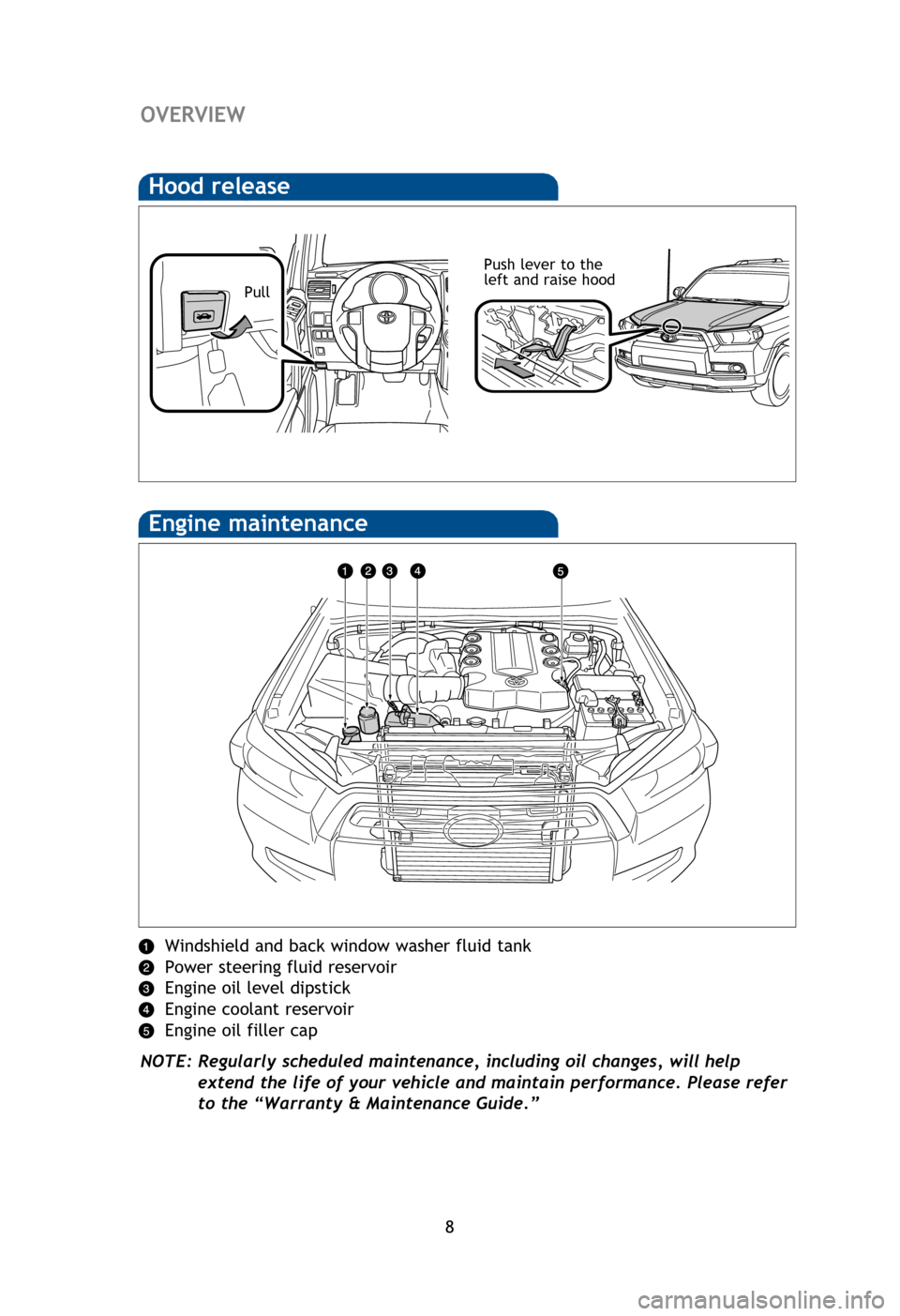
8
Windshield and back window
washer fluid tank
Power steering fluid reservoir
Engine oil level dipstick
Engine coolant reservoir
Engine oil filler cap
NOTE: Regularly scheduled maintenance, including oil changes, will help extend the life of your vehicle and maintain performance. Please refer
to the “Warranty & Maintenance Guide.”
Engine maintenance
Hood release
Pull
Push lever to the
left and raise hood
OVERVIEWFEATURES/OPERATIONS
Automatic Transmission
* The ignition/“ENGINE START STOP” switch must be “ON” and the brake pedal depressed to shift from Park.
Shift the shift lever to “S” position from “D” position.
+: Upshift (push and release)
-: Downshift (pull and release)
Downshifting increases power going uphill, or provides engine braking downhill.
For best fuel economy during normal driving conditions, always drive with the shift
lever in the “D” position.
“S” (Sequential) mode
Auto lock/unlock
Automatic door locks can be programmed to operate in four different modes, or
turned OFF.
-Doors lock when shifting from Park.
-Doors lock when the vehicle speed is approximately 12 mph or higher.
-Doors unlock when shifting into Park.
-Doors unlock when the driver’s door is opened within 10 seconds after turning the “ENGINE START STOP” switch or ignition switch OFF.
Refer to the Owner’s Manual for more details.
Parking brake
126892_20134Runner.indd 88/6/12 10:41 PM
Page 11 of 32
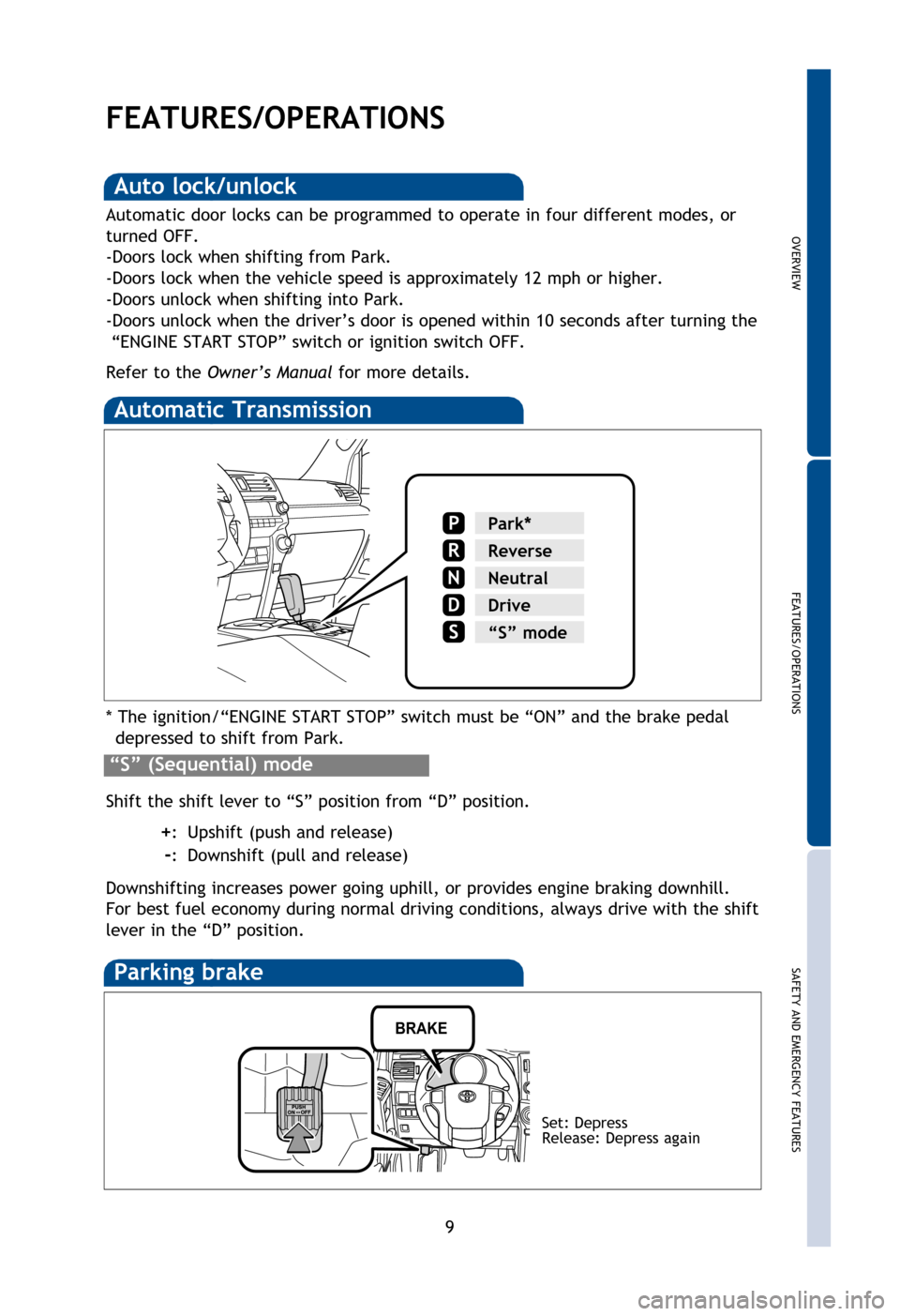
OVERVIEW
FEATURES/OPERATIONS
SAFETY AND EMERGENCY FEATURES
9
Windshield and back window
washer fluid tank
Power steering fluid reservoir
Engine oil level dipstick
Engine coolant reservoir
Engine oil filler cap
NOTE: Regularly scheduled maintenance, including oil changes, will help extend the life of your vehicle and maintain performance. Please refer
to the “Warranty & Maintenance Guide.”
FEATURES/OPERATIONS
Automatic Transmission
* The ignition/“ENGINE START STOP” switch must be “ON” and the brake pedal depressed to shift from Park.
Shift the shift lever to “S” position from “D” position.
+: Upshift (push and release)
-: Downshift (pull and release)
Downshifting increases power going uphill, or provides engine braking downhill.
For best fuel economy during normal driving conditions, always drive with the shift
lever in the “D” position.
“S” (Sequential) mode
Park*
Reverse
Neutral
Drive
P
R
N
D
“S” mode
Auto lock/unlock
Automatic door locks can be programmed to operate in four different modes, or
turned OFF.
-Doors lock when shifting from Park.
-Doors lock when the vehicle speed is approximately 12 mph or higher.
-Doors unlock when shifting into Park.
-Doors unlock when the driver’s door is opened within 10 seconds after turning the “ENGINE START STOP” switch or ignition switch OFF.
Refer to the Owner’s Manual for more details.
Parking brake
Set: Depress
Release: Depress again
BRAKE
126892_20134Runner.indd 98/6/12 10:41 PM
Page 24 of 32
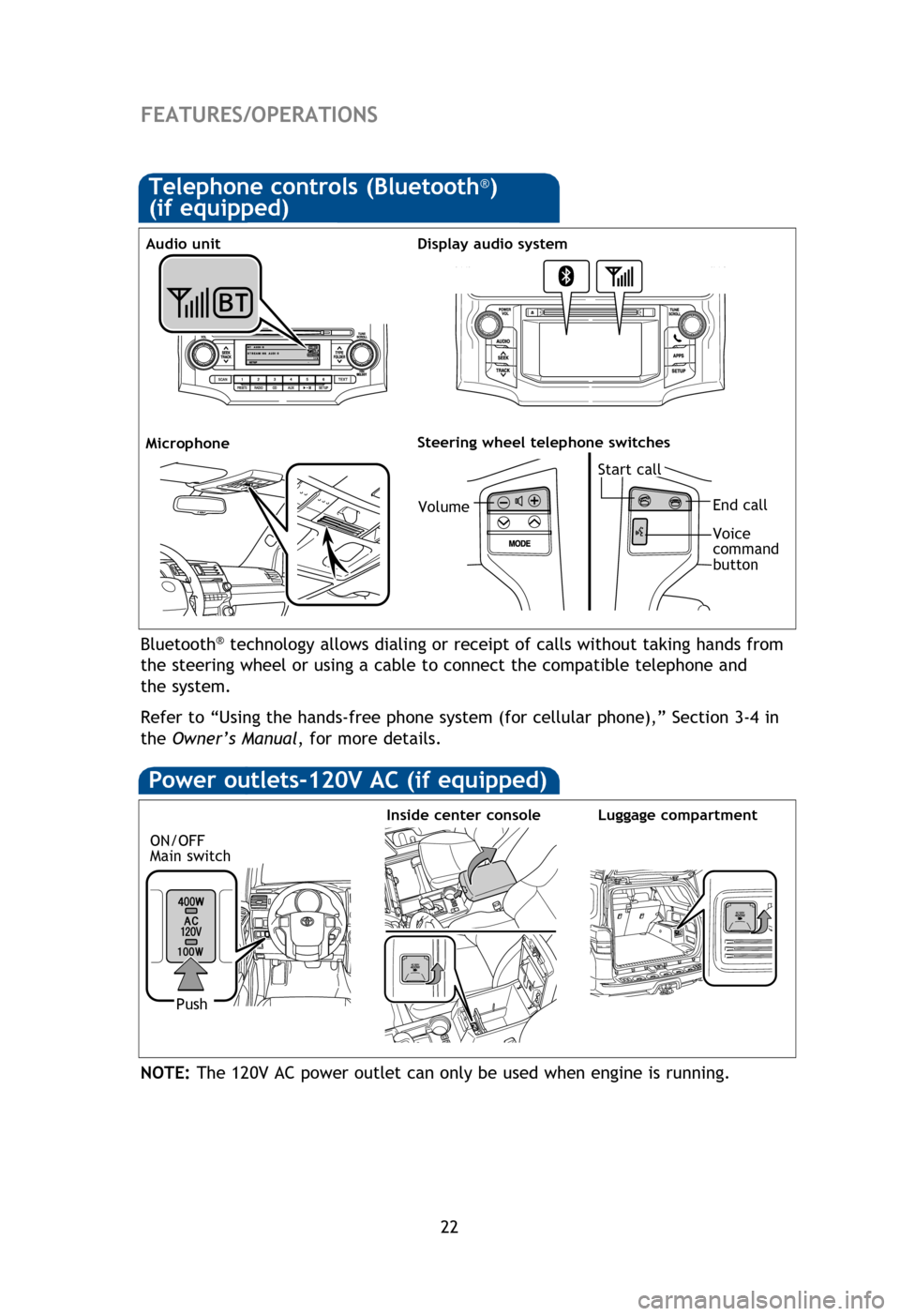
22
FEATURES/OPERATIONS
Bluetooth® technology allows dialing or receipt of calls without taking hands from
the steering wheel or using a cable to connect the compatible telephone and
the system.
Refer to “Using the hands-free phone system (for cellular phone),” Section 3-4 in
the Owner’s Manual , for more details.
Telephone controls (Bluetooth®)
(if equipped)
Microphone
Audio unit
Steering wheel telephone switches
End call
Voice
command
button
Start call
The Bluetooth® audio system enables you to enjoy music played on a portable
digital audio player from the vehicle speaker via wireless communication.
Refer to “Bluetooth
® audio system,” Section 3-3 in the Owner’s Manual , for
more details.
Microphone Audio unit
Bluetooth® audio (if equipped)
NOTE: Designed for car accessories. Ignition switch/“ENGINE START STOP” switch
must be in the “ACC” or “ON” position to be used.
Power outlets-12V DC
Center panel
Luggage compartment
(with the 120V AC outlet)
NOTE: The 120V AC power outlet can only be used when engine is running.
Power outlets-120V AC (if equipped)
ON/OFF
Main switch
Inside center console
Push
Luggage compartment
Volume
Display audio system
126892_20134Runner.indd 228/6/12 10:41 PM
Page 25 of 32
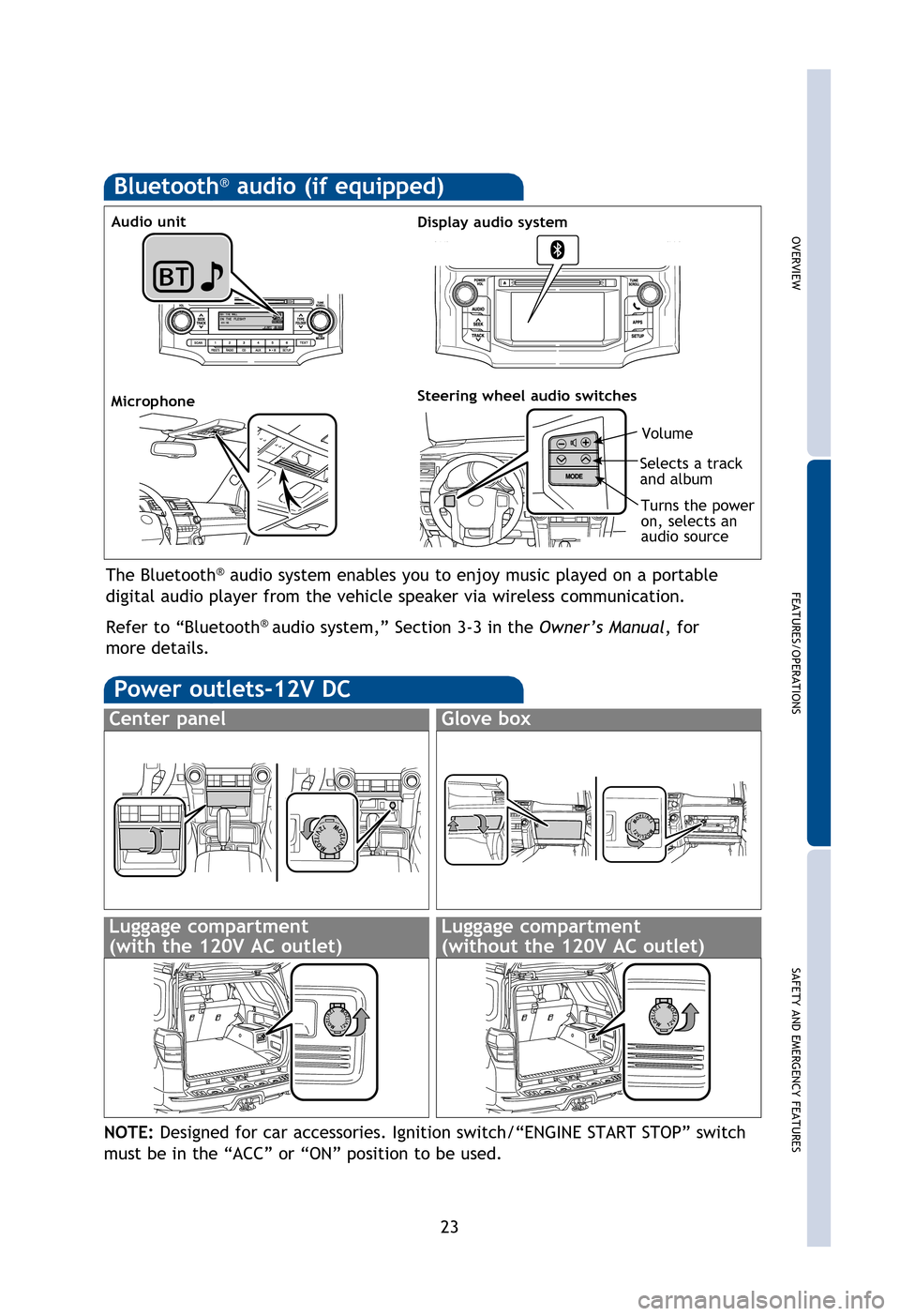
OVERVIEW
FEATURES/OPERATIONS
SAFETY AND EMERGENCY FEATURES
23
FEATURES/OPERATIONS
Bluetooth® technology allows dialing or receipt of calls without taking hands from
the steering wheel or using a cable to connect the compatible telephone and
the system.
Refer to “Using the hands-free phone system (for cellular phone),” Section 3-4 in
the Owner’s Manual , for more details.
End call
Voice
command
button
The Bluetooth® audio system enables you to enjoy music played on a portable
digital audio player from the vehicle speaker via wireless communication.
Refer to “Bluetooth
® audio system,” Section 3-3 in the Owner’s Manual , for
more details.
Microphone Audio unitSteering wheel audio switches
Selects a track
and album
Turns the power
on, selects an
audio source
Volume
Bluetooth® audio (if equipped)
NOTE: Designed for car accessories. Ignition switch/“ENGINE START STOP” switch
must be in the “ACC” or “ON” position to be used.
Power outlets-12V DC
Center panel
Luggage compartment
(with the 120V AC outlet)
Glove box
Luggage compartment
(without the 120V AC outlet)
NOTE: The 120V AC power outlet can only be used when engine is running.
Luggage compartment
Display audio system
126892_20134Runner.indd 238/6/12 10:41 PM
Page 28 of 32
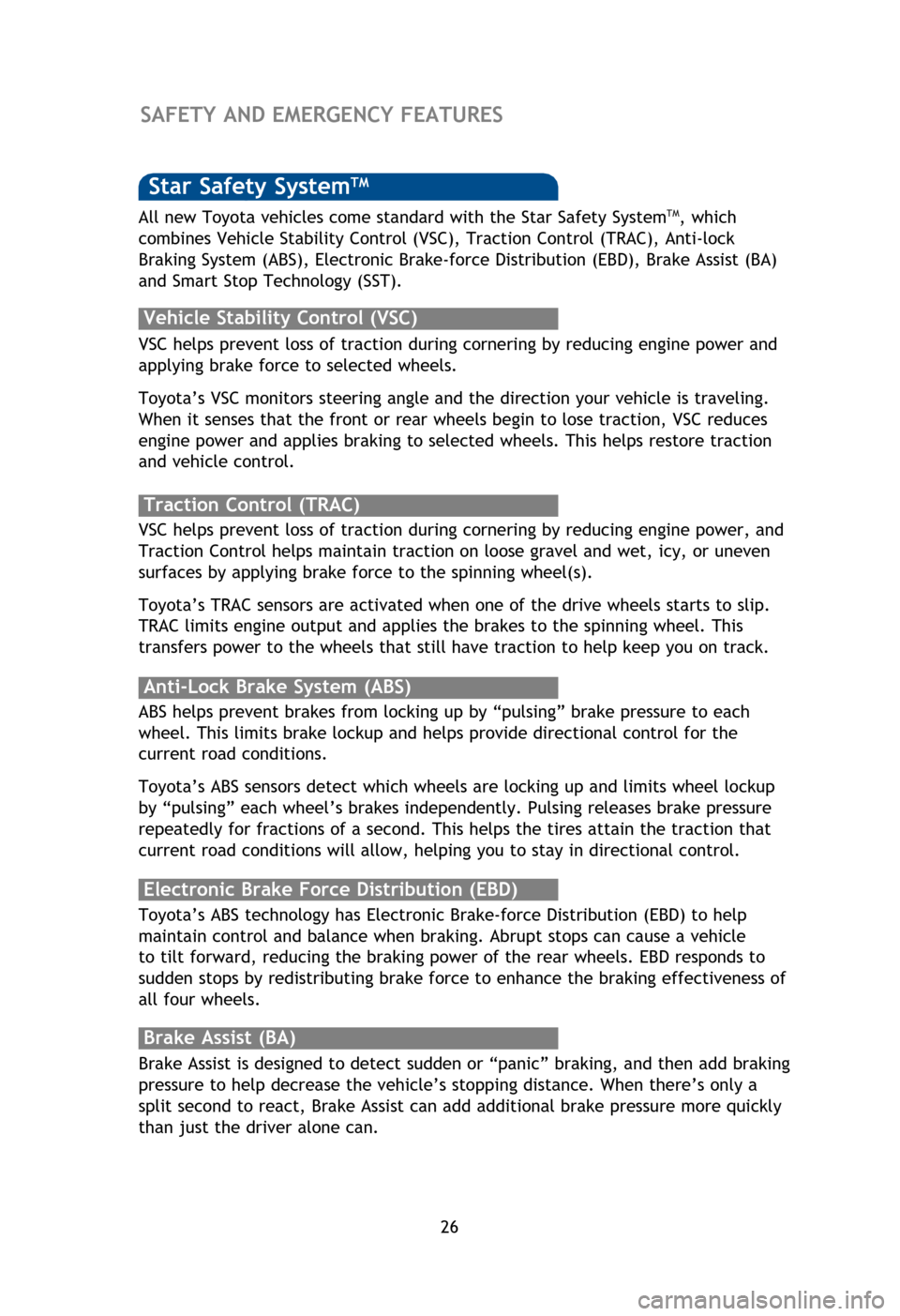
26
There are two types of Toyota floor mats: carpeted and all-weather. Each vehicle
has model-specific floor mats. Installation is easy.
To keep your floor mat properly positioned, follow these steps:
• Only use floor mats designed for your specific model.
• Use only one floor mat at a time, using the retaining hooks to keep the mat in
place.
• Install floor mats right side up.
Floor mat installation
SAFETY AND EMERGENCY FEATURES
Smart Stop Technology automatically reduces engine power when the accelerator
and brake pedals are pressed simultaneously under certain conditions.
SST engages when the accelerator is depressed first and the brakes are applied
firmly for longer than one-half second at speeds greater than five miles per hour.
SST doesn’t engage if the brake pedal is depressed before the accelerator pedal,
allowing vehicles to start on a steep hill and safely accelerate without rolling
backward.
Smart Stop Technology (SST)Star Safety SystemTM
VSC helps prevent loss of traction during cornering by reducing engine power and
applying brake force to selected wheels.
Toyota’s VSC monitors steering angle and the direction your vehicle is traveling.
When it senses that the front or rear wheels begin to lose traction, VSC reduces
engine power and applies braking to selected wheels. This helps restore traction
and vehicle control.
Vehicle Stability Control (VSC)
Anti-Lock Brake System (ABS)
ABS helps prevent brakes from locking up by “pulsing” brake pressure to each
wheel. This limits brake lockup and helps provide directional control for the
current road conditions.
Toyota’s ABS sensors detect which wheels are locking up and limits wheel lockup
by “pulsing” each wheel’s brakes independently. Pulsing releases brake pressure
repeatedly for fractions of a second. This helps the tires attain the traction that
current road conditions will allow, helping you to stay in directional control.
Brake Assist (BA)
Brake Assist is designed to detect sudden or “panic” braking, and then add braking
pressure to help decrease the vehicle’s stopping distance. When there’s only a
split second to react, Brake Assist can add additional brake pressure more quickly
than just the driver alone can. VSC helps prevent loss of traction during cornering by reducing engine power, and
Traction Control helps maintain traction on loose gravel and wet, icy, or uneven
surfaces by applying brake force to the spinning wheel(s).
Toyota’s TRAC sensors are activated when one of the drive wheels starts to slip.
TRAC limits engine output and applies the brakes to the spinning wheel. This
transfers power to the wheels that still have traction to help keep you on track.
Traction Control (TRAC)
Electronic Brake Force Distribution (EBD)
Toyota’s ABS technology has Electronic Brake-force Distribution (EBD) to help
maintain control and balance when braking. Abrupt stops can cause a vehicle
to tilt forward, reducing the braking power of the rear wheels. EBD responds to
sudden stops by redistributing brake force to enhance the braking effectiveness of
all four wheels. All new Toyota vehicles come standard with the Star Safety System
TM, which
combines Vehicle Stability Control (VSC), Traction Control (TRAC), Anti-lock
Braking System (ABS), Electronic Brake-force Distribution (EBD), Brake Assist (BA)
and Smart Stop Technology (SST).
126892_20134Runner.indd 268/6/12 10:42 PM
Page 29 of 32
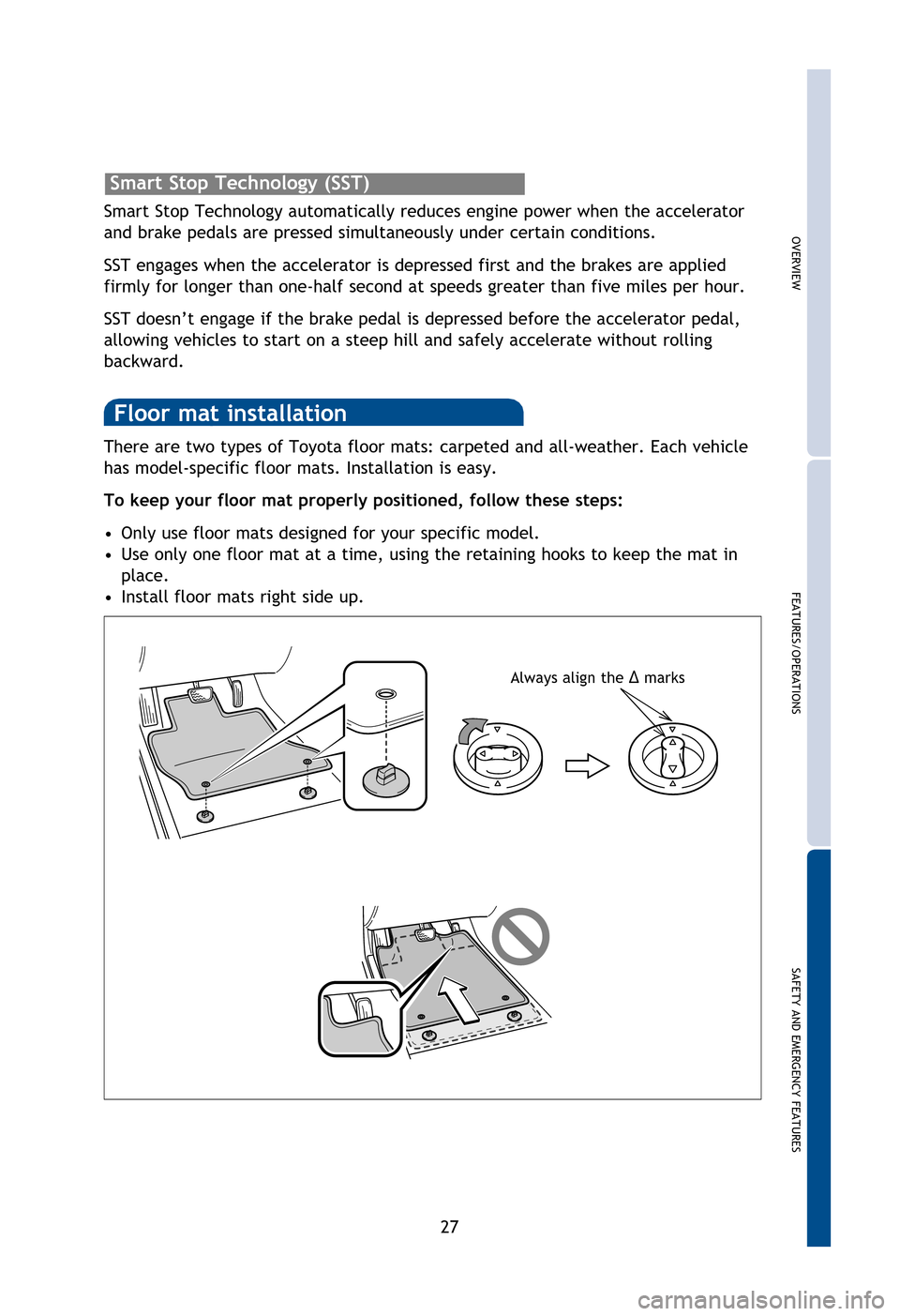
OVERVIEW
FEATURES/OPERATIONS
SAFETY AND EMERGENCY FEATURES
27
There are two types of Toyota floor mats: carpeted and all-weather. Each vehicle
has model-specific floor mats. Installation is easy.
To keep your floor mat properly positioned, follow these steps:
•
Only use floor mats designed for your specific model.
• Use only one floor mat at a time, using the retaining hooks to keep the mat in
place.
• Install floor mats right side up.
Floor mat installation
SAFETY AND EMERGENCY FEATURES
Smart Stop Technology automatically reduces engine power when the accelerator
and brake pedals are pressed simultaneously under certain conditions.
SST engages when the accelerator is depressed first and the brakes are applied
firmly for longer than one-half second at speeds greater than five miles per hour.
SST doesn’t engage if the brake pedal is depressed before the accelerator pedal,
allowing vehicles to start on a steep hill and safely accelerate without rolling
backward.
Smart Stop Technology (SST)
VSC helps prevent loss of traction during cornering by reducing engine power and
applying brake force to selected wheels.
Toyota’s VSC monitors steering angle and the direction your vehicle is traveling.
When it senses that the front or rear wheels begin to lose traction, VSC reduces
engine power and applies braking to selected wheels. This helps restore traction
and vehicle control.
ABS helps prevent brakes from locking up by “pulsing” brake pressure to each
wheel. This limits brake lockup and helps provide directional control for the
current road conditions.
Toyota’s ABS sensors detect which wheels are locking up and limits wheel lockup
by “pulsing” each wheel’s brakes independently. Pulsing releases brake pressure
repeatedly for fractions of a second. This helps the tires attain the traction that
current road conditions will allow, helping you to stay in directional control.
Brake Assist is designed to detect sudden or “panic” braking, and then add braking
pressure to help decrease the vehicle’s stopping distance. When there’s only a
split second to react, Brake Assist can add additional brake pressure more quickly
than just the driver alone can. VSC helps prevent loss of traction during cornering by reducing engine power, and
Traction Control helps maintain traction on loose gravel and wet, icy, or uneven
surfaces by applying brake force to the spinning wheel(s).
Toyota’s TRAC sensors are activated when one of the drive wheels starts to slip.
TRAC limits engine output and applies the brakes to the spinning wheel. This
transfers power to the wheels that still have traction to help keep you on track.
Toyota’s ABS technology has Electronic Brake-force Distribution (EBD) to help
maintain control and balance when braking. Abrupt stops can cause a vehicle
to tilt forward, reducing the braking power of the rear wheels. EBD responds to
sudden stops by redistributing brake force to enhance the braking effectiveness of
all four wheels. All new Toyota vehicles come standard with the Star Safety System
TM, which
combines Vehicle Stability Control (VSC), Traction Control (TRAC), Anti-lock
Braking System (ABS), Electronic Brake-force Distribution (EBD), Brake Assist (BA)
and Smart Stop Technology (SST).
Always align the Δ marks
126892_20134Runner.indd 278/6/12 10:42 PM